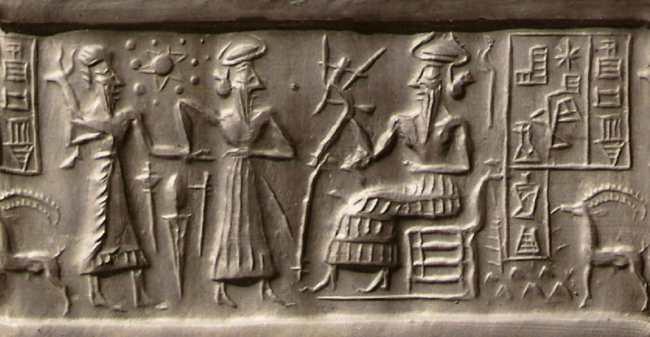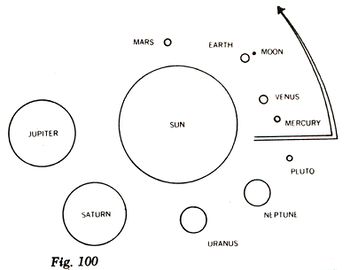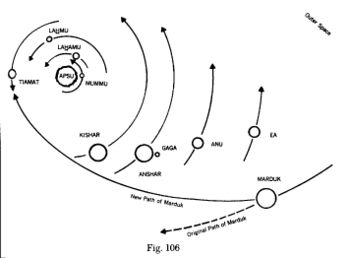VA243 Cylinder Seal
By Joseph Pease

The VA 243 Cylinder Seal is an artifact of Sumerian origin, and in the realm of pseudoarchaeology, purported to be real evidence of contact between that ancient civilization and extraterrestrial beings. In his book, The 12th Planet Zecharia Sitchin theorizes that the Sumerians had advanced knowledge of the stars, planets, and other heavenly spheres due to the involvement of the alien beings from the twelfth planet beyond Neptune, Nibiru[2]. This book uses the cylinder seal as a evidential centerpiece, with its inscriptions being a "secret code" that points to the Sumerian cosmological knowledge, hidden in plain sight, of a solar system not known to man until the 19th and 20th centuries.
Context
Annunaki and "Planet" Nibiru
The Annunaki were divine entities within the myths and religions of ancient Mesopotamia. These deities can be found among the various cultural myths of the region, from the Babylonians to the Akkadians and Assyrians[3]. These deities are shrouded in mystery, as little evidence of their worship remains. From what can be ascertained from surviving representations and records, these gods had various roles and aspects in the different regions of the ancient Middle East. Within the Sumerian mythos, these gods are descended from the sky, but their specific roles aren't exactly known. They are, however, associated with the heavenly bodies in Sumerian cosmology. Inana (Venus), Utu (Sun), and Nanna (Moon) are principal among them, with others representing various other stellar spaces[4]. This vagueness of substance and evidence has made the ethereal Annunaki a common sight in pseudoarchaeological theories, being seen as alien beings who came to the earth to guide, enslave, or create human beings and civilizations. Their representative connections to the planets of our solar system also lends credence to these theories by giving them a mythological and allegorical framework for amateur theorists to work with.
The "Planet" Nibiru is posited by Sitchin as the twelfth planet of our solar system, lying beyond Neptune. Why twelve? According to Sitichin, he categorizes Nibiru as the twelfth planet due to Sumerian cosmology accepting the moon as a full planetary body as well as that of Pluto (a body not discovered or known to humanity until 1930)[5]. Nibiru is said to be an ancient world from the time of the solar system's formation, and the homeworld of the Annunaki as an advanced alien civilization. It is associated with the god Marduk, and according to Sitchin is the god-alien's palatial home from which he visited the earth in the distant past. The planet itself is more reasonable as a theory (in the eyes of its proponents) in that it is within the confines of the solar system, making the travel between worlds a far more realistic possibility than aliens from beyond the stars[6]. Even the name of this speculated world has been misrepresented by pseudoarchaeologists. The word "nibiru" comes from a Babylonian term for a crossing. Within the cosmology of Mesopotamia, it has shown by cuneiform linguists that the nibiru of Marduk (the name associated with planet Nibiru) aligns not with a new planet, but the crossing of Jupiter from one hemisphere to another[7].
Cylinder Seals
Cylinder seals, the devices in which Sitchin derives his evidence for the Twelfth Planet, are ancient pieces of clay shaped into cylindrical forms and almost always covered in unique engravings, art, or hieroglyphics/cuneiform. These were used throughout the Bronze Age, from Egypt to Babylon, as devices to determine property rights and ownership. The person who had the seal was the owner of whatever property it marked[8]. For one to use these seals, they would roll them across a clay object (or other soft material) rendering their seal from the cylindrical form to a two dimensional image. This was civilization's earliest form of both stamping and formal signatures. Seal shape varied with both geography and time, but their images tended to be commemorative or spiritual. The VA 243 seal depicts a seated man receiving offerings from two standing figures, between whom lie a star shaped symbol. That symbol would largely be what inspires the idea of Nibiru. There is also some gazelle on the sides and a natural setting, but this is probably ornamentation. Inscribed on the right and left sides of the artifact is cuneiform script, saying "Dubsiga, Ili-Iliat, Your (or His) Servant"[9]. Dubsiga nor Ili-Iliat are not known names within any of the mythologies of Mesopotamia, and it is safe to assume that they are indeed mortal men, the owner of the seal and the master/employer/ruler he is honoring.
Psuedoarchaeological Narrative

The narrative in which the VA243 seal is the centerpiece is one of an alternate cosmology based on the Sumerian knowledge. Sitchin states that the seal's star and globe shapes in the upper left corner are a depiction of the solar system and evidence of advanced astronomical knowledge. This supposed knowledge made the Mesopotamians far more developed and aware of the universe than all following civilizations up to the present day. It was "given" to them by the Annunaki, visiting beings from the far outer world, Nibiru. In the seventh chapter of his work, The Epic of Creation[11], Sitchin uses that image as evidence and a justification for making a twelve world (remember that Pluto and The Moon are both given planetary status) framework for our solar system. By combining Sumerian myth and text with Sitchin's contemporary knowledge of astronomy, he explains how the twelve world solar system was formed, and why Nibiru has not been seen since the Bronze Age.
The narrative begins at the beginning of time. Sitchin builds his case by interpreting the Enuma Elish, The Babylonian Creation myth, as a direct representation of the formation of the entire solar system. In the Enuma Elish, the tablets tell the story of the creation of the heavens and the earth, as well as the birth of the deities that were worshiped by the Sumerians and Babylonians. Sitchin posits that these are not gods solely, but the name for the planets as told by the Sumerians who knew them well[12]. This is not an uncommon phenomenon in ancient myths. The Romans and Greeks both associated the planets with their gods, and named them accordingly based on their appearance and motion[13]. Thus Sitchin names each world "known" to the Sumerians and equates them with a god from their pantheon. The Sun is Apsu, Mercury is Mummu, Tiamat is a "missing world", Lahmu and Lahamu were Mars and Venus, Kishar and Anshar are Jupiter and Saturn, and finally Anu, Ea, and Gaga. These were Uranus, Neptune and Pluto, worlds that would not officially be discovered for another few millenia[14]. He quotes the Enuma Elish:
21~The divine brothers came together,
22~Their clamour got loud, throwing Tia-mat into a turmoil.
23~They jarred the nerves of Tia-mat,
24~And by their dancing they spread alarm in Anduruna(Heaven).
25~Apsû did not diminish their clamour,
26~And Tia-mat was silent when confronted with them.[15]
In this we can interpret that this "must" signify the erratic orbits of the early solar system. The worlds were a jumbled mess, and were flying about in any which way, leading to destruction and chaos. In this chaos a new god/planet was born in the deepest areas of Space. Marduk was formed outside the great web of inner orbits, and pulled deeply into the solar system by his parent god Ea (Neptune)[16]. Marduk (Nibiru) entered the solar system counter to the orbits of the rest of the worlds, and as it supposedly got pulled deeper inside the system, gravity pulled this world's orbit ever deeper and more erratic...setting it on a collision course with Tiamat.

93~Tia-mat and Marduk, the sage of the gods, came together,
94~Joining in strife, drawing near to battle.
95~Be-l spread out his net and enmeshed her;
96~He let loose the Evil Wind, the rear guard, in her face.
97~Tia-mat opened her mouth to swallow it,
98~She let the Evil Wind in so that she could not close her lips.
99~The fierce winds weighed down her belly,
100~Her inwards were distended and she opened her mouth wide.
101~He let fly an arrow and pierced her belly,
102~He tore open her entrails and slit her inwards,
103~He bound her and extinguished her life,[18]
This description of a heavenly battle between Tiamat and Marduk is explained to be a metaphorical or misunderstood representation of the planetary collision of Marduk and Tiamat. This battle or collision resulted in the total destruction of Tiamat and the supreme victory of Marduk. Tiamat's body was shattered and her host reversed their direction at Marduk's triumphant approach. These are clear indications of a familiarity with planetary collisions, according to Sitchin. He would later explain that Marduk would use Tiamat's corpse to create a great "hammered bracelet" (the asteroid belt) and a new world, a reincarnation of Tiamat. This would be the Earth. The former partner of Tiamat, the great world of Kingu, was forced to become the Earth's bound partner. Our moon[19]. Marduk would later retreat to the outer solar system, and be the home of the gods, Nibiru.
Debunking Sitchin's Centerpiece
When we shift our focus back to the VA 243 Seal, we can really see that its importance as evidence is really tenuous. The entire crux of the argument with the seal is based on an interpretation of a tiny image on one small part of this seal. Sitchin uses the star and orbs around it as evidence signifying that the Sumerians were aware of the structure of the solar system. Sitchin's interpretation of this seal is entirely dependent on the star shape being the Sun, and not anything else. Yet Sumerologists have made different interpreations of these seals, and they tend to fall largely in line with established historical and archaeological evidence.
"The alleged 'sun' symbol on the seal is not the sun. We know this because it does not conform to the consistent depiction of the sun in hundreds of other cylinder seals and examples of Sumero-Mesopotamian artwork....The 'sun' symbol is actually a star....The Sumerians and Mesopotamians distinguished the sun from stars by using different symbols – and associating each symbol with the sun god and other gods, respectively."[20]
Heiser also explains that smaller circles are also stars, and that like depictions of the Pleiades, are also represented as dots. He also notes that like the Pleiades, these stars potentially represent gods. [21][22]. These stars were deities, not the planets (from Sitchin's point of view). Which stars do they represent? We don't know, but a solar system is something they do not represent. Sitchin, like he does with the artifact itself, takes the star-and-dot image out of the context of the seal's other depictions and inscriptions. As was described previously, the inscription shows a that the man Ili-Iliat is rendering an offering to someone of higher status named Dubsiga. Given the setting of grasslands and fauna in the background, one can interpret the image at large as an agricultural offering, and that the stars and circles are indicative of a divine supplication/blessing of the interaction. While a symbol of a sun would fit well within the agricultural setting, this isn't it. The star does not match any known other cylinder seals that do have suns upon them, nor even the famous solar symbol of Shumash[23]. Beyond the artifact, we all know there are not twelve planets...and with the reclassification of Pluto in 2005 there aren't even nine. The cylinder seal is hardly evidence for any extraterrestrial contact, as it has been blatantly misconstrued and misread. There is no great evidence for any large planet beyond Neptune...so far[24].
References
- ↑ Museum artifact published by Anton Moortgat, "West Asian Cylinder Seals," Vorderasiatische Rollsiegel (1940)
- ↑ Sitchin, Zecharia 2016 "The 12th Planet". Ishi Press International, Bronx, NY
- ↑ Black, Jeremy; Green, Anthony (1992), Gods, Demons and Symbols of Ancient Mesopotamia: An Illustrated Dictionary, London, England: The British Museum Press, Pg.34
- ↑ Black, Jeremy; Green, Anthony (1992), Gods, Demons and Symbols of Ancient Mesopotamia: An Illustrated Dictionary, London, England: The British Museum Press, Pg.108-109, 182, 135
- ↑ Sitchin, Zecharia 2016 The 12th Planet. Ishi Press International, Bronx, NY p. 164
- ↑ Sitchin, Zecharia 2016 The 12th Planet. Ishi Press International, Bronx, NY p. 166-170
- ↑ Freedman, Immanuel 2015 "Marduk Star Nebiru". Cuneiform Digital Library Bulletin: 1–4 https://cdli.ucla.edu/files/publications/CDLB2015_003.pdf
- ↑ Ward, Willaim Hayes 1910 The Seal Cylinders of Western Asia. Vol. 100. Carnegie Institution of Washington P.33
- ↑ Heiser, Michael S. "The Myth of a 12th Planet: A Brief Analysis of Cylinder Seal VA 243 ". University of Madison-Wisconsin: p.4 http://www.michaelsheiser.com/VA243seal.pdf
- ↑ Sitchin, Zecharia 2016 The 12th Planet. Ishi Press International, Bronx, NY p. 189
- ↑ Sitchin, Zecharia 2016 The 12th Planet. Ishi Press International, Bronx, NY p. 187-214
- ↑ Sitchin, Zecharia 2016 The 12th Planet. Ishi Press International, Bronx, NY p. 194
- ↑ Falkner, David E. 2011 The Mythology of the Night Sky an Amateur Astronomers Guide to the Ancient Greek and Roman Legends. Springer New York, New York, NY p.169
- ↑ Sitchin, Zecharia 2016 The 12th Planet. Ishi Press International, Bronx, NY p. 195
- ↑ Lambert, W.G. "Enuma Elish" (The Babylonian Epic of Creation). etana.org. Electronic Tools And Near East Archives, August 29 2008 http://www.etana.org/node/581
- ↑ Sitchin, Zecharia 2016 The 12th Planet. Ishi Press International, Bronx, NY p. 200
- ↑ Sitchin, Zecharia 2016 The 12th Planet. Ishi Press International, Bronx, NY p. 201
- ↑ Lambert, W.G. "Enuma Elish" (The Babylonian Epic of Creation). etana.org. Electronic Tools And Near East Archives, August 29 2008 http://www.etana.org/node/581
- ↑ Sitchin, Zecharia 2016 The 12th Planet. Ishi Press International, Bronx, NY p. 212
- ↑ Heiser, Michael S. "The Myth of a 12th Planet: A Brief Analysis of Cylinder Seal VA 243 ". University of Madison-Wisconsin: p.2 http://www.michaelsheiser.com/VA243seal.pdf
- ↑ Heiser, Michael S. "The Myth of a 12th Planet: A Brief Analysis of Cylinder Seal VA 243 ". University of Madison-Wisconsin: p.2 http://www.michaelsheiser.com/VA243seal.pdf
- ↑ Verderame, Lorenzo 2016 PLEIADES IN ANCIENT MESOPOTAMIA. Mediterranean Archaeology and Archaeometry 16(4): 109–116 http://maajournal.com/Issues/2016/Vol16-4/Full15.pdf
- ↑ Heiser, Michael S. "The Myth of a 12th Planet: A Brief Analysis of Cylinder Seal VA 243 ". University of Madison-Wisconsin: p.5-10 http://www.michaelsheiser.com/VA243seal.pdf
- ↑ Burdick, A. 2017. July 6. “Discovering Planet Nine.” The New Yorker. https://www.newyorker.com/tech/annals-of-technology/discovering-planet-nine